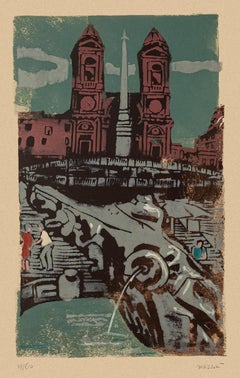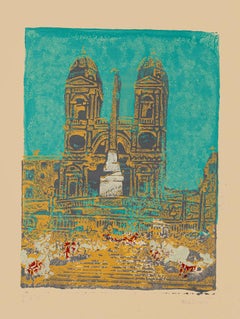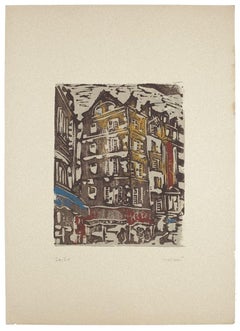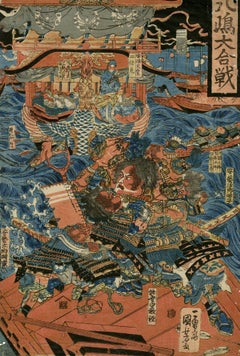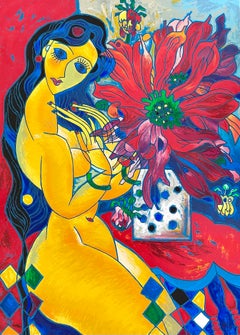Carlo Mazzoni Art
1
to
4
3
1
2
1
1
Overall Height
to
Overall Width
to
1
2
2
1
1
1
1
4
1
4
6,996
3,377
2,513
1,212
3
2
1
Artist: Carlo Mazzoni
Trinità dei Monti - Original Screen Print by Carlo Mazzoni - Late 20th Century
By Carlo Mazzoni
Located in Roma, IT
Trinità dei Monti is an original screen print realized by Carlo Mazzoni.
Hand-signed by the artist in pencil on the lower right corner.
Edition 19/60
Good conditions.
This artwo...
Category
Late 20th Century Carlo Mazzoni Art
Materials
Screen, Paper
Navona Square - Screen Print by Carlo Mazzoni - Late 20th Century
By Carlo Mazzoni
Located in Roma, IT
Navona Square - Rome is an original serigraph realized by Carlo Mazzoni (1922).
Hand-signed by the artist in pencil on the lower right corner. Numbered on the lower-left corner. Edi...
Category
Late 20th Century Modern Carlo Mazzoni Art
Materials
Screen
Trinità dei Monti - Original Screen Print by Carlo Mazzoni - Late 20th Century
By Carlo Mazzoni
Located in Roma, IT
Trinità dei Monti is an original screen print realized by Carlo Mazzoni.
Hand-signed by the artist in pencil on the lower right corner.
Artist's proof.
Good conditions.
This art...
Category
Late 20th Century Carlo Mazzoni Art
Materials
Paper, Screen
Houses - Woodcut by Carlo Mazzoni - 1977
By Carlo Mazzoni
Located in Roma, IT
Houses in the city is an original woodcut realized by Carlo Mazzoni.
Hand-signed by the artist in pencil on the lower right corner. Numbered on the lower-left corner. Edition 24/60....
Category
1970s Carlo Mazzoni Art
Materials
Woodcut
Related Items
The Battle of Dan-no-ura in Yashima, Nagato Province in the First Year .....
By Utagawa Yoshitora
Located in Middletown, NY
The Battle of Dan-no-ura in Yashima, Nagato Province in the First Year of the Bunji Era (1185)
Tokyo c. 1830
Woodblock print (nishiki-e) with ink and hand-coloring in watercolor on handmade mulberry paper, 14 7/16 x 9 15/16 inches (367 x 252 mm), ōban tate-e, the full sheet. In good condition with some handling creases. Colors are fresh and extremely vibrant. The right panel from the triptych by Yoshitora depicting one of Japan's most storied naval battles. An impression of this work may be found in the permanent collection of the Honolulu Museum of Art.
The great naval battle of Dan-no-ura in 1185 was the final climax in a long series of bitter wars between two powerful families in feudal Japan...
Category
Early 19th Century Edo Carlo Mazzoni Art
Materials
Handmade Paper, Watercolor, Woodcut
Beauty & Flowers, Tie Feng Jiang
By Tie Feng Jiang
Located in Fairfield, CT
Artist: Jiang Tie-Feng (1938)
Title: Beauty & Flowers
Year: 1994
Medium: Silkscreen on Vellum Rag paper
Edition: 269/300, plus proofs
Size: 43 x 31.25 inches
Condition: Good
Inscript...
Category
1980s Pop Art Carlo Mazzoni Art
Materials
Screen
The Pilgrimage Procession to Kinryuzan Temple at Asakusa in the Eastern Capital
By Kuniyasu
Located in Soquel, CA
Japanese Parade - Woodblock Print
Japanese woodblock print by Utagawa Kuniyasu (歌川 国安) (Japan, 1794–1832). Japanese women, dressed in blue and red kimonos, are the focal point. A vi...
Category
Mid-19th Century Edo Carlo Mazzoni Art
Materials
Paper, Ink, Woodcut
Original "Wagon Lits" pop art style serigraph travel by train poster
By Valerio Adami
Located in Spokane, WA
Original “Wagon Lits” serigraph poster by the artist Valerio Adami.
It was printed in France by GrafiCaza (Michel Caza), one of the finest serigraph companies on woven paper—in exce...
Category
1990s American Modern Carlo Mazzoni Art
Materials
Screen
H 36 in W 24 in D 0.05 in
Modernist Silkscreen Screenprint 'El Station, Interior' NYC Subway, WPA Artist
By Anthony Velonis
Located in Surfside, FL
screenprint printed in color ink on wove paper. New York City subway station interior.
Anthony Velonis (1911 – 1997) was an American painter and designer born in New York City who helped introduce the public to silkscreen printing in the early 20th century.
While employed under the federal Works Progress Administration, WPA during the Great Depression, Velonis brought the use of silkscreen printing as a fine art form, referred to as the "serigraph," into the mainstream. By his own request, he was not publicly credited for coining the term.
He experimented and mastered techniques to print on a wide variety of materials, such as glass, plastics, and metal, thereby expanding the field. In the mid to late 20th century, the silkscreen technique became popular among other artists such as Robert Rauschenberg and Andy Warhol.
Velonis was born into a relatively poor background of a Greek immigrant family and grew up in the tenements of New York City. Early on, he took creative inspiration from figures in his life such as his grandfather, an immigrant from the mountains in Greece, who was "an ecclesiastical painter, on Byzantine style." Velonis attended James Monroe High School in The Bronx, where he took on minor artistic roles such as the illustration of his high school yearbook. He eventually received a scholarship to the NYU College of Fine Arts, into which he was both surprised and ecstatic to have been admitted. Around this time he took to painting, watercolor, and sculpture, as well as various other art forms, hoping to find a niche that fit. He attended NYU until 1929, when the Great Depression started in the United States after the stock market crash.
Around the year 1932, Velonis became interested in silk screen, together with fellow artist Fritz Brosius, and decided to investigate the practice. Working in his brother's sign shop, Velonis was able to master the silkscreen process. He reminisced in an interview three decades later that doing so was "plenty of fun," and that a lot of technology can be discovered through hard work, more so if it is worked on "little by little."
Velonis was hired by Mayor LaGuardia in 1934 to promote the work of New York's city government via posters publicizing city projects. One such project required him to go on a commercial fishing trip to locations including New Bedford and Nantucket for a fortnight, where he primarily took photographs and notes, and made sketches. Afterward, for a period of roughly six months, he was occupied with creating paintings from these records. During this trip, Velonis developed true respect and affinity for the fishermen with whom he traveled, "the relatively uneducated person," in his words.
Following this, Velonis began work with the Public Works of Art Project (PWAP), an offshoot of the Civil Works Administration (CWA), where he was assigned to serve the different city departments of New York. After the formation of the federal Works Progress Administration, which hired artists and sponsored projects in the arts, he also worked in theater.
Velonis began working for the federal WPA in 1935. He kept this position until 1936 or 1938, at which point he began working in the graphic art division of the Federal Art Project, which he ultimately led. Under various elements of the WPA program, many young artists, writers and actors gained employment that helped them survive during the Depression, as well as contributing works that created an artistic legacy for the country.
When interviewed in December 1994 by the Library of Congress about his time in the WPA, Velonis reflected that he had greatly enjoyed that period, saying that he liked the "excitement" and "meeting all the other artists with different points of view." He also said in a later interview that "the contact and the dialogue with all those artists and the work that took place was just invaluable." Among the young artists he hired was Edmond Casarella, who later developed an innovative technique using layered cardboard for woodcuts.
Velonis introduced silkscreen printing to the Poster Division of the WPA. As he recalled in a 1965 interview: "I suggested that the Poster division would be a lot more productive and useful if they had an auxiliary screen printing project that worked along with them. And apparently this was very favorably received..."
As a member of the Federal Art Project, a subdivision of the WPA, Velonis later approached the Public Use of Arts Committee (PUAC) for help in "propagandizing for art in the parks, in the subways, et cetera." Since the Federal Art Project could not be "self-promoting," an outside organization was required to advertise their art more extensively. During his employment with the Federal Art Project, Velonis created nine silkscreen posters for the federal government.
Around 1937-1939 Velonis wrote a pamphlet titled "Technical Problems of the Artist: Technique of the Silkscreen Process," which was distributed to art centers run by the WPA around the country. It was considered very influential in encouraging artists to try this relatively inexpensive technique and stimulated printmaking across the country.
In 1939, Velonis founded the Creative Printmakers Group, along with three others, including Hyman Warsager. They printed both their own works and those of other artists in their facility. This was considered the most important silkscreen shop of the period.
The next year, Velonis founded the National Serigraph Society. It started out with relatively small commercial projects, such as "rather fancy" Christmas cards that were sold to many of the upscale Fifth Avenue shops...
Category
1980s American Modern Carlo Mazzoni Art
Materials
Screen
SPRING IN GETTYSBURG
By Kay Ameche
Located in Aventura, FL
Serigraph on paper. Hand signed and numbered by the artist. Sheet size: 22.75 x 28.5 inches. Image size: 17 x 23 inches. Edition of 250.
Artwork is in excellent condition. Cert...
Category
1980s Contemporary Carlo Mazzoni Art
Materials
Paper, Screen
Dragon Ride, Limited edition print, Cycling, Sports, Bike art, Silk Screen print
By Eliza Southwood
Located in Deddington, GB
'Dragon Ride' by Eliza Southwood is a bright, colourful and beautiful Limited Edition silkscreen print on paper.
Eliza Says: "Screen printing is a fairly technical hand-made printing...
Category
2010s Contemporary Carlo Mazzoni Art
Materials
Paper, Screen
H 27.56 in W 19.69 in D 0.04 in
Eyvind Earle Contemporary Serigraph "Eucalyptus Forest"
By Eyvind Earle
Located in Alamo, CA
This striking contemporary abstract serigraph by Eyvind Earle (1916-2000) is entitled "Eucalyptus Forest". It depicts a stylized scene of cloud like trees with a radiating pattern in the foreground, possibly tilled fields. It is signed in pencil in the lower right and numbered in pencil 119/267 in the lower left.
This colorful print is presented in a glossy black wood frame with a French mat...
Category
Late 20th Century Contemporary Carlo Mazzoni Art
Materials
Screen
H 24.25 in W 26 in D 1.25 in
Elements - Surfing Art - Figurative - Woodcut Print By Marc Zimmerman
By Marc Zimmerman
Located in Carmel, CA
Elements - Surfing Art - Figurative - Woodcut Print By Marc Zimmerman
Limited Edition 01/04
This masterwork is exhibited in the Zimmerman Gallery, Carmel CA.
Immerse yourself in t...
Category
2010s Contemporary Carlo Mazzoni Art
Materials
Woodcut
Rosa and Jude
Located in Deddington, GB
Rosa and Jude by Amy Gardner [2021]
limited_edition
Mono Print/Screen Print
Edition number 30
Image size: H:45 cm x W:65 cm
Complete Size of Unframed Work: H:45 cm x W:65 cm x D:0.1...
Category
21st Century and Contemporary Pop Art Carlo Mazzoni Art
Materials
Monoprint, Screen, Paper
La Jolla - Surfing Art - Figurative - Woodcut Print By Marc Zimmerman
By Marc Zimmerman
Located in Carmel, CA
La Jolla - Surfing Art - Figurative - Woodcut Print By Marc Zimmerman
Limited Edition 01/04
This masterwork is exhibited in the Zimmerman Gallery, Carmel CA.
Immerse yourself in t...
Category
2010s Contemporary Carlo Mazzoni Art
Materials
Woodcut
'Serving Poi', Hawaii, NYMoMA, Metropolitan Museum, National Gallery, SFAA, GGIE
By Marion Osborn Cunningham
Located in Santa Cruz, CA
Stamped, verso, with certification of authenticity for 'Marion Cunningham' (American, 1908-1948) and created in 1948.
Paper dimensions: 17.75 x 16 inches
A substantial and rare, mid-century silkscreen showing a Hawaiian family seated beneath a traditional tent of tapa cloth and being served poi by a young woman. To realize this complex work, Cunningham used as many as one dozen hand-drawn screens, each of which varied in pigment, hue and opacity. Created during the extraordinary creative ferment that characterized the last year of the artist's life, this work represents a remarkable achievement for both artist and medium.
Born in Indiana, Marion Osborn Cunningham moved to California in 1911. She first studied art with the American Impressionist, Ruth Heil Emerson, before continuing her education at Santa Barbara City College and receiving her Bachelor of Arts from Stanford University. She subsequently furthered her studies at the California School of the Fine Arts and at the Art Students League in New York City, where she met and married the American abstract artist Ben Cunningham. Returning to San Francisco...
Category
1940s Modern Carlo Mazzoni Art
Materials
Screen, Paper
Carlo Mazzoni art for sale on 1stDibs.
Find a wide variety of authentic Carlo Mazzoni art available for sale on 1stDibs. You can also browse by medium to find art by Carlo Mazzoni in screen print, paper, woodcut print and more. Much of the original work by this artist or collective was created during the 20th century and is mostly associated with the modern style. Not every interior allows for large Carlo Mazzoni art, so small editions measuring 11 inches across are available. Customers who are interested in this artist might also find the work of Bruno Conte, Eugene Corneau, and Mario Logli. Carlo Mazzoni art prices can differ depending upon medium, time period and other attributes. On 1stDibs, the price for these items starts at $222 and tops out at $290, while the average work can sell for $273.
